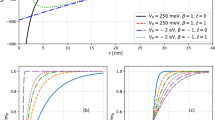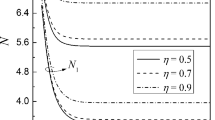Abstract
In this paper, the asymmetric Gaussian confinement potential (AGCP) and the parabolic confinement potential (PCP) are selected to describe the along growth direction and perpendicular to growth direction confinement potential (PC) of electron in a disk quantum dot, respectively. The energies of the ground and internal-excited states of the electron in a quantum dot with the thickness effect are investigated by using the Pekar-type variational method, and on the basis of the Fermi Golden Rule, the transition of the electron caused by the electric field and magnetic field are discussed. This quantum system in nanostructure can be employed as a two-level quantum qubit. Our numerical results have displayed that the electric field or magnetic field is not only an indispensable condition for the induced electron transition, but its different values have a strong regulatory function on the transition probability; the influence of the well width \( L \) and the well depth \( V_{0} \) of the AGCP on the transition probability \( Q \) and frequency \( \omega \) are important and interesting; it is also found in this work that the AGCP is better than PCP in explaining the quantum size effect of QDs and modulating electron transition properties, respectively. This work confirms that the choice of a confinement potential is crucial for the study of electron transition in nanostructures.








Similar content being viewed by others
References
Adamowski J, Sobkowicz M, Szafran B et al (2000) Electron pair in a Gaussian confining potential. Phys Rev B 62:4234–4237
Bai XF, Zhang Y, Wuyunqimuge et al (2016) Properties of strong-coupling magneto-bipolaron qubit in quantum dot under magnetic field. Chin Phys B 25:077804-1–077804-6
Chen YJ, Xiao JL (2017) Influences of the temperature on the parabolic quantum dot qubit in the magnetic field. J Low Temp Phys 186:241–249
Chen CY, Li WS, Teng XY et al (1998) Polaron in a quantum disk. Phys B 245:92–102
Chi F, Zheng J, Liu YS et al (2012) Refrigeration effect in a single-level quantum dot with thermal bias. Appl Phys Lett 100:233106–233109
Griffiths DJ (2005) Introduction to quantum mechanics. Pearon Education, Inc., Upper Saddle River
Gu J, Liang LQ (2005) Energy spectrum analysis of donor-center quantum dot. Acta Phys Sin 54:5335–5338 (in Chinese)
Guo Y, Sun LL, Chi F (2014) Heat generation by electric current in a quantum dot molecular coupled to ferromagnetic leads. Commun Theor Phys 62:423–429
Huybrechts JJ (1976) Note on the ground-state energy of the Feynman polaron. Phys C Solid State Phys 9:L211–L212
Khordad R, Sedehi HRR (2017) Application of different entropies to study of bound magnetopolaron in an asymmetric quantum dot. Indian J Phys 91:825–831
Landau LD, Pekar SI (1948) Effective mass of a polaron. Zh Eksp Teor Fiz 18:419–423
Lee TD, Low FM, Pines SD (1953) The motion of slow electrons in a crystal. Phys Rev 90:297–302
Ma XJ, Xiao BY, Sun Y et al (2015) Effects of magnetic field on the polaron in an asymmetrical Gaussian confinement potential quantum well. J Semicond 36:102004-1–102004-4
Medeiros-Ribeiro G, Leonard D, Petroff PM (1995) Electron and hole energy levels in InAs self-assembled quantum dots. Appl Phys Lett 66:1767–1769
Miao XJ, Sun Y, Xiao JL (2015) Effect of impurities on the properties of bound polarons in an asymmetric Gaussian confinement potential quantum well. Korean Phys Soc 67:1197–1200
Pekar SI (1954) Untersuchungen über die Elektronen-theorie der Kristalle. Akademie Verlag, Berlin
Shi L, Yan ZW (2011) Effects of electric field and shape on the bound polaron in a Wurtzite ellipsoidal finite-potential quantum dot. J Appl Phys 110:024306
Shi L, Yan ZW (2015) Polaronic effect on linear and nonlinear optical properties of spherical quantum dots under electric field. Solid State Commun 209–210:27–32
Wang XQ, Xiao JL (2017) The effect of magnetic field on rbcl asymmetric quantum dot qubit. Iran J Sci Technol Trans Sci 41:273–276
Wang ZW, Li WP, Yin JW et al (2008) Properties of parabolic linear bound potential and coulomb bound potential quantum dot qubit. Commun Theor Phys 49:311–314
Wang HY, Dou XM, Yang S et al (2014) Photoluminescence enhancement of the single InAs quantum dots through plasmonic Au island films. J Appl Phys 115:123104–123108
Wu XF, Wei H, Dou XM et al (2014) In situ tuning biexciton antibinding–binding transition and fine-structure splitting through hydrostatic pressure in single InGaAs quantum dots. Europhys Lett 107:27008–27013
Xiao JL (2013) The effect of electric field on an asymmetric quantum dot qubit. Quantum Inf Process 12:3707–3716
Xiao W, Qi B, Xiao JL (2015) Impurity effect of asymmetric gaussian potential quantum well qubit. J Low Temp Phys 179:166–174
Yin JW, Xiao JL, Yu YF et al (2009) The influence of electric field on a parabolic quantum dot qubit. Chin Phys B 18:0446–0450
Zhao CL, Cai CY, Xiao JL (2013) Influence of an anisotropic parabolic potential on the quantum dot qubit. J Semicond 34:112002-1–112002-4
Zhou PY, Wu XF, Ding K et al (2015) Coupling and single-photon purity of a quantum dot-cavity system studied using hydrostatic pressure. J Appl Phys 117:014304–014307
Acknowledgements
This work was supported by the Open Research Fund of The State Key Laboratory of Superlattices and Microstructures (No. CHJG200701) and the Nature Science Foundation of Hebei Province, China (Grant No. E2013407119).
Author information
Authors and Affiliations
Corresponding author
Rights and permissions
About this article
Cite this article
Bai, XF., Zhao, YW., Xin, W. et al. Transition Probability and Frequency of an Electron in an Asymmetric Gaussian Confinement Potential Quantum Dot with Electromagnetic Field. Iran J Sci Technol Trans Sci 43, 2027–2034 (2019). https://doi.org/10.1007/s40995-019-00684-7
Received:
Accepted:
Published:
Issue Date:
DOI: https://doi.org/10.1007/s40995-019-00684-7




